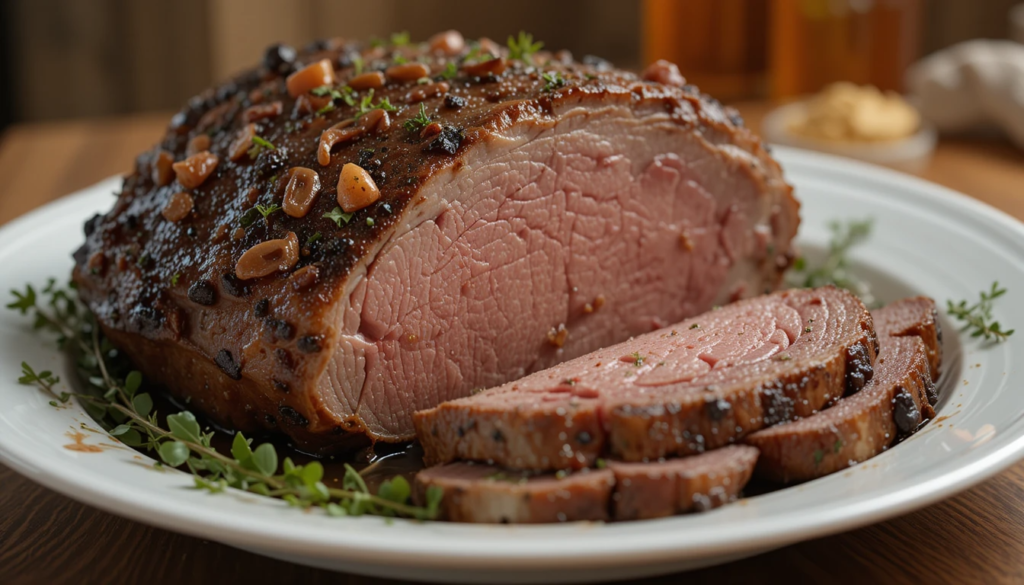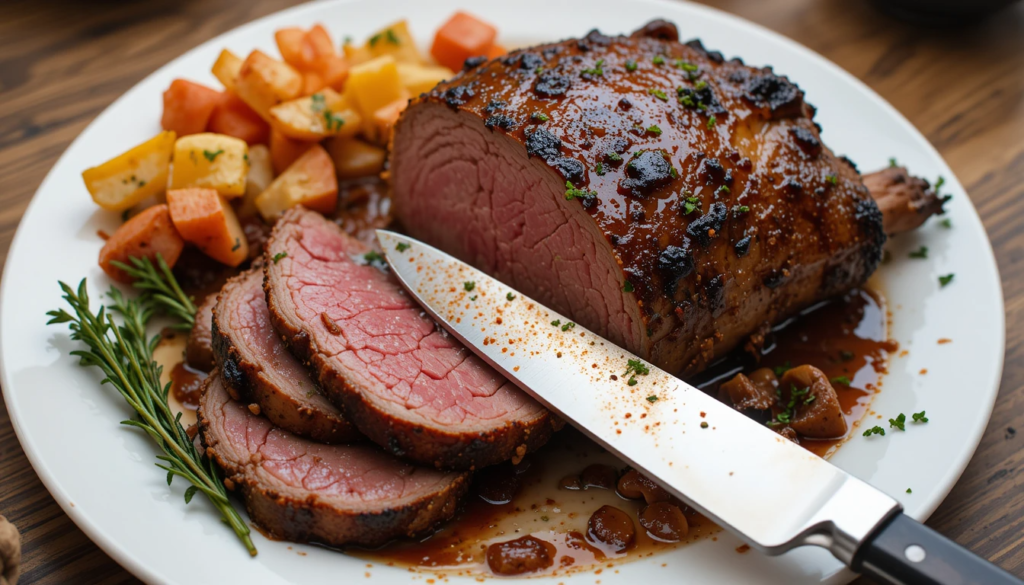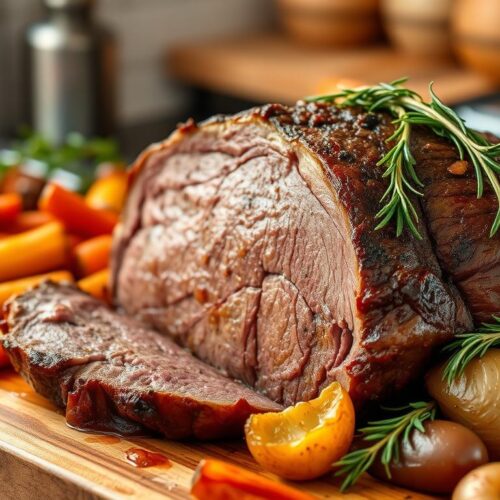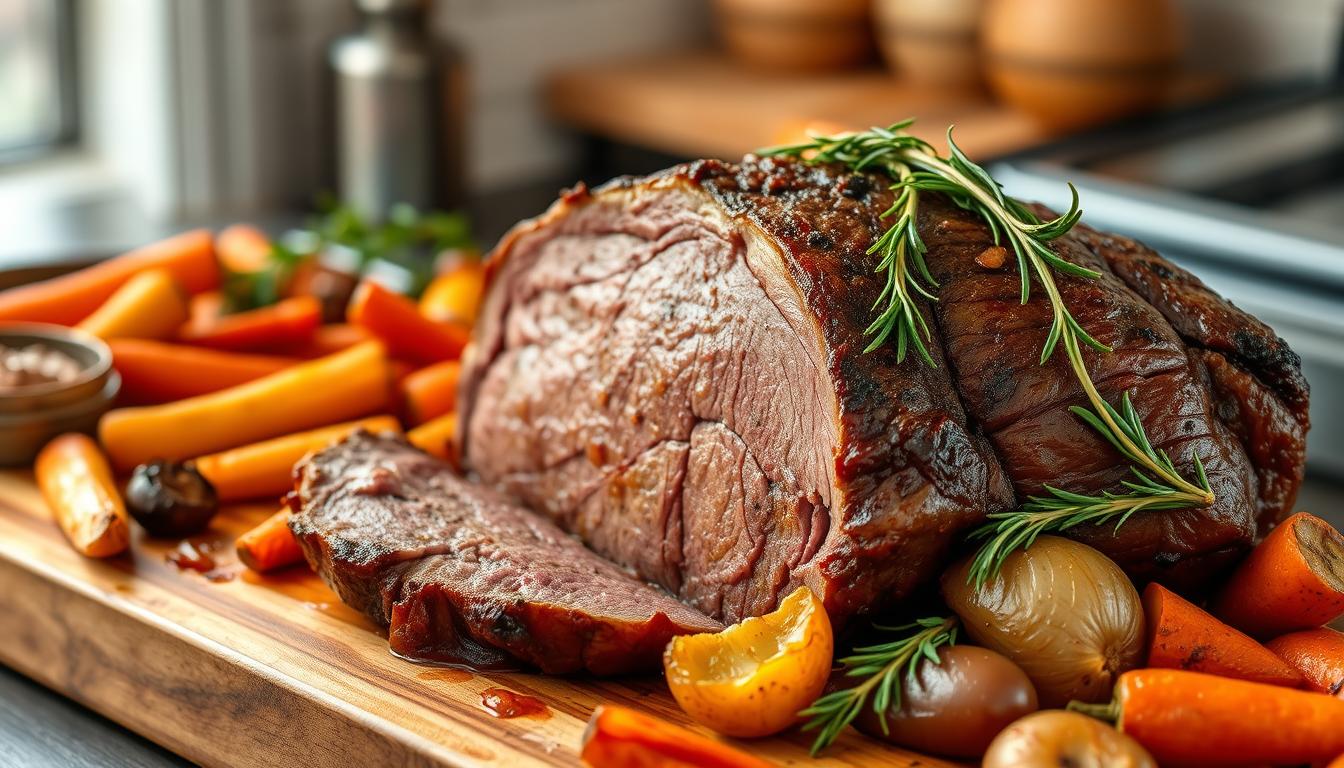Imagine biting into a tender, juicy bottom round roast. It’s cooked just right, with a tasty crust outside and a flavorful inside. To get this, you need to learn the best cooking methods and recipes.
For a 3-pound roast, cooking takes about 1 hour and 20 minutes. The perfect internal temperature is 135ºF to 140°F for medium-rare. This makes a dish that will wow your family and friends.
As you start this cooking journey, you’ll learn how to pick the right meat, season it, and cook it. The bottom round roast is lean and can be cooked perfectly with the right techniques and ingredients. Each serving has about 195 calories, with 25g of protein, 10g of fat, and 0.3g of carbs.
By following a simple recipe and using the right cooking techniques, you can make a delicious bottom round roast. It’s perfect for any occasion. With the right guidance, you’ll create a roast that’s not only tasty but also healthy. So, let’s dive into the world of bottom round roast cooking techniques and recipes.
Table of Contents
Understanding Bottom Round Roast: What Makes This Cut Special
The bottom round roast is a top pick for beef roasting. It comes from the cow’s rear leg and is both tender and flavorful. This cut is about 90% lean, making it a favorite for those watching their diet.
This cut has less fat than others, like the ribeye. It’s packed with high-quality protein and vitamins like B vitamins, iron, zinc, and selenium. These nutrients make it great for those trying to eat less fat and calories.
Characteristics of Bottom Round Roast
- Lean cut of beef with approximately 90% lean meat
- Low fat content, with about 20-30% less fat compared to fattier cuts
- High-quality protein, with an estimated 25 grams of protein per 3.5-ounce serving
- Rich in essential B vitamins and minerals like iron, zinc, and selenium
Nutritional Benefits
The bottom round roast is low in calories, with about 200 per 3.5 ounces cooked. It’s also full of vitamins and minerals. Choosing this cut helps you eat less saturated fat and manage calories.
Why Choose This Cut for Roasting
The bottom round roast is perfect for roasting because it’s tender and flavorful. Braising or slow roasting makes it even softer. Plus, marinades with acid can help. It’s a healthy and tasty choice for roast beef.
| Cut of Beef | Fat Content | Protein Content | Calorie Count |
|---|---|---|---|
| Bottom Round Roast | 10-15% | 25g per 3.5oz serving | 200 calories per 3.5oz serving |
| Ribeye | 30-40% | 20g per 3.5oz serving | 300 calories per 3.5oz serving |
Essential Equipment for Perfect Roasting
To get a perfectly cooked bottom round roast, you need the right roasting equipment and cooking tools. These kitchen essentials are key to preparing and cooking your roast just right. A Dutch oven or roasting pan is a must for cooking the perfect bottom round roast.
Here are some essential items for your kitchen essentials list:
- Meat thermometer
- Roasting pan
- Kitchen twine
These cooking tools help you get a perfectly cooked roast. A meat thermometer makes sure the roast is cooked to a safe temperature. Kitchen twine keeps the roast tied and secure while it cooks.
Using the right roasting equipment and cooking tools can greatly improve your roast’s quality. By getting these kitchen essentials, you’ll cook a delicious and tender bottom round roast that will impress everyone.
Remember, having the right equipment and tools is key for a perfectly cooked roast. With these kitchen essentials, you’re on your way to a delicious and memorable meal.
Preparing Your Bottom Round Roast Recipe
To make a delicious and tender bottom round roast recipe, you need to prepare it right. This means trimming and tying the roast, adding the right seasoning, and using a good marinade. These steps help improve the roast’s flavor and tenderness.
For seasoning, you can pick from many herbs and spices. Garlic, rosemary, and thyme are favorites. Or, you can use a store-bought seasoning blend, like Montreal steak seasoning, for ease.
A great marinade can also tenderize the roast and add flavor. Mix olive oil, acid (like vinegar or lemon juice), and spices for a tasty marinade. Options include olive oil, garlic, and herbs, or soy sauce, brown sugar, and ginger.
By following these tips, you can make a tasty and tender bottom round roast. Always use the right recipe preparation techniques. This includes trimming and tying the roast, adding the right seasoning, and using a good marinade for the best results.
Temperature Guidelines and Cooking Times
Getting the right cooking temperature is key when cooking a bottom round roast. For medium-rare, aim for 135°F. Medium and medium-well should be 145°F and 150°F, respectively. Always use a digital meat thermometer to check these temperatures.
The cooking time varies based on the roast’s size. A good rule is 20-25 minutes per pound. This helps ensure your roast is cooked evenly.
Start by setting your oven to 375°F for the first 30 minutes. Then, lower it to 225°F to avoid overcooking. A 3-4 pound roast will take about 2-3 hours to cook.
Here’s a quick guide to help you:
- Medium-rare: 135°F internal temperature, 20-25 minutes per pound
- Medium: 145°F internal temperature, 20-25 minutes per pound
- Medium-well: 150°F internal temperature, 20-25 minutes per pound
- Initial oven temperature: 375°F for the first 30 minutes
- Lower cooking temperature: 225°F after the initial 30 minutes


By following these guidelines, you’ll make a delicious bottom round roast. Always check with a meat thermometer to get the internal temperature right. Adjust the cooking time as needed for your desired doneness.
| Doneness | Internal Temperature | Cooking Time per Pound |
|---|---|---|
| Medium-rare | 135°F | 20-25 minutes |
| Medium | 145°F | 20-25 minutes |
| Medium-well | 150°F | 20-25 minutes |
Mastering the Roasting Process
To get a perfectly roasted bottom round roast, you need to know the roasting techniques. First, searing the roast is key. It makes a tasty crust. You can sear it in a hot skillet or broil it in the oven for a few minutes.
After searing, it’s time for oven cooking. Cook the roast at about 325°F. The cooking time varies by roast size, but aim for 20-25 minutes per pound. Oven roasting is excellent for even cooking and keeping juices in.
Key Roasting Techniques
- Searing the roast to create a flavorful crust
- Cooking the roast in a preheated oven using oven roasting techniques
- Basting the roast with juices to keep it moist and tender
By using these techniques, you’ll get a delicious bottom round roast. Always check the roast’s internal temperature with a meat thermometer. Also, try different seasonings and marinades to enhance the flavor.
| Cooking Method | Cooking Time | Internal Temperature |
|---|---|---|
| Oven Roasting | 20-25 minutes per pound | 135°F (54°C) |
| Sous Vide | 24-30 hours | 135°F (57°C) |
| Slow Cooking | 8 hours | 160°F (71°C) |
Resting and Carving Your Roast
After cooking your bottom round roast, it’s crucial to let it rest. This resting time helps the juices spread out. This makes the meat tender and juicy. The best resting time is 10-30 minutes, based on the roast’s size.
When carving, use the right carving techniques. Slice the meat against the grain with a sharp knife. Try for slices that are less than 1/4 inch thick. This keeps the meat tenderness and makes serving easier.
Here are some tips for carving your roast:
- Use a sharp knife to prevent tearing the meat
- Slice against the grain for more tender slices
- Aim for slices that are no more than 1/4 inch thick


By following these tips and letting your roast rest, you’ll enjoy a delicious, tender, and juicy bottom round roast. It will have perfect meat tenderness.
Troubleshooting Common Problems
When cooking a bottom round roast, you might face some common issues. Cooking issues like overcooking or underseasoning can be a bummer. But, there are ways to fix these problems. Knowing the basics of cooking a bottom round roast is key to avoiding common mistakes.
Temperature control is crucial when cooking a bottom round roast. If it’s too hot, the roast can dry out. If it’s too cold, it won’t cook evenly. Use a meat thermometer to keep an eye on the roast’s internal temperature.
Here are some tips for troubleshooting common problems when cooking a bottom round roast:
- Use a meat thermometer to ensure the roast reaches a safe internal temperature.
- Don’t overcook the roast, as this can make it dry and tough.
- Let the roast rest for 15-20 minutes before slicing to allow the juices to redistribute.
By following these tips and being mindful of common mistakes, you can make a delicious and tender bottom round roast. Remember to stay calm and patient when troubleshooting any cooking issues. Don’t be afraid to try new recipes and techniques to find what works best for you.
With practice and experience, you’ll get better at troubleshooting common problems. You’ll be able to make a perfectly cooked bottom round roast every time.
| Common Mistakes | Troubleshooting Tips |
|---|---|
| Overcooking | Use a meat thermometer to monitor internal temperature |
| Underseasoning | Let the roast rest for 15-20 minutes before slicing |
| Dryness | Don’t overcook the roast, and use a marinade or rub to add flavor |
Serving Suggestions and Side Dishes
When serving your bottom round roast, think about different side dishes to match its flavor. There are over 30 roast beef dinner sides to choose from. You can pair it with mashed potatoes, roasted veggies, or creamy scalloped potatoes for a classic taste.
For something new, try Air Fryer Mashed Potatoes or Gluten Free Scalloped Potatoes. These are tasty and quick to make, ready in under 30 minutes. Here are some side dish ideas that go well with bottom round roast:
- Brown Sugar Glazed Carrots, made with 4 ingredients in 15 minutes
- Creamed Corn Casserole, needing 5 ingredients and 30 minutes to bake
- Southern Sweet Potato Casserole, with creamy sweet potatoes and a brown sugar pecan topping
Plan your meal carefully, picking sides that enhance your roast’s flavor. With a bit of creativity, you can make a meal that impresses everyone. Consider Brussels Sprouts & Kale Sauté, Butternut Squash Mac and Cheese, or Quinoa with Roasted Vegetables for your meal planning. By choosing a variety of side dishes, you’ll create a memorable meal that suits your taste.
Conclusion: Mastering Your Bottom Round Roast
Cooking the perfect bottom round roast at home is within reach. With the right techniques and patience, you can do it. This article has given you the knowledge to make a delicious roast that will wow your loved ones.
The secret to success is knowing the meat’s unique traits. Season and marinate it well. Then, master the roasting process.
With practice, you’ll make tender, tasty bottom round roasts every time. Feel free to try new seasoning blends or marinades. This cut is great for meal prep and family gatherings because it’s affordable and versatile.
Now, go ahead and improve your bottom round roast skills. Enjoy the journey and the tasty results of your cooking. Happy cooking!


Bottom Round Roast Recipe
Ingredients
- 3- pound bottom round roast
- 2 tbsp olive oil
- 2 cloves garlic minced
- 1 tbsp fresh rosemary chopped
- 1 tsp dried thyme
- 1 tsp salt
- 1/2 tsp black pepper
Optional marinade:
- 1/4 cup olive oil
- 2 tbsp balsamic vinegar
- 1 tsp Dijon mustard
- 1 clove garlic minced
Instructions
Preparing the Roast
- Trim and Tie: Remove excess fat and tie the roast with kitchen twine for even cooking.
- Season: Rub the roast with olive oil, garlic, rosemary, thyme, salt, and pepper. For added flavor, marinate the roast in the optional marinade for 4-8 hours in the refrigerator.
Searing the Roast
- Preheat a skillet over medium-high heat. Sear the roast on all sides until golden brown (about 2 minutes per side). This step locks in flavor and creates a crust.
Roasting
- Preheat your oven to 375°F (190°C). Place the roast in a roasting pan or Dutch oven.
- Cook at 375°F for 30 minutes, then lower the temperature to 225°F (107°C).
- Roast for approximately 20-25 minutes per pound, or until the internal temperature reaches:
- Medium-rare: 135°F (57°C)
- Medium: 145°F (63°C)
- Medium-well: 150°F (66°C)
Resting the Roast
- Remove the roast from the oven and let it rest on a cutting board for 15-20 minutes. This allows the juices to redistribute.
Carving
- Use a sharp knife to slice the roast against the grain into thin slices (about 1/4 inch thick). Serve immediately.
Notes
Nutrition Information (Per Serving)
- Calories: 195
- Protein: 25g
- Fat: 10g
- Carbohydrates: 0.3g
- Cholesterol: 70mg
- Sodium: 55mg
FAQ
What are the characteristics of bottom round roast?
Bottom round roast is a lean cut of meat. It’s tender and flavorful. It’s great for roasting because it’s nutritious and works well with slow cooking.
What equipment is necessary for perfect roasting?
You’ll need a meat thermometer, roasting pan, and kitchen twine for perfect roasting. These tools help you get the meat just right and keep it in shape.
How should I prepare the bottom round roast for roasting?
Start by trimming and tying the roast. Season and marinate it to boost flavor and tenderness. These steps make a big difference in the final dish.
What temperature should I cook the bottom round roast to?
Cook the roast to 130°F for medium-rare or 140°F for medium. A meat thermometer is key to getting it just right.
How do I master the roasting process for the bottom round roast?
To master roasting, sear the roast first for a flavorful crust. Use the right oven techniques and baste it during cooking. These steps ensure a tender, juicy interior.
How should I rest and carve the bottom round roast?
Let the roast rest for 15-20 minutes before carving. This lets the juices spread evenly. Carve against the grain for the best tenderness and flavor.
What are some common problems I might encounter when cooking the bottom round roast?
You might face overcooking, underseasoning, or a tough texture. To fix these, adjust cooking times, seasonings, and techniques. This will help you get a perfect roast.
What are some serving suggestions and side dish ideas for the bottom round roast?
Pair the roast with roasted potatoes, steamed veggies, and rich gravy for a classic taste. For something new, try roasted root veggies or a fresh salad. These add a modern twist to the dish.
Your Flavorful Feedback
There are no reviews yet. Be the first one to write one.

